Question
Practice Calculations Calculate monthly C.O.G.S. assuming a 30% mark-up and the following 6 months sales figures: $4000, $4500, $5000, $6000, $7500, $7500. Repeat calculations assuming
Practice Calculations
-
Calculate monthly C.O.G.S. assuming a 30% mark-up and the following 6 months sales figures:
-
$4000, $4500, $5000, $6000, $7500, $7500.
-
Repeat calculations assuming gross contribution margin of 40%.
-
-
Assuming average monthly sales of $50,000 and average monthly C.O.G.S. of $30,000, calculate the expected level of
-
Receivables if average collection period is 55 days.
-
Inventory if you plan on average 40 days on hand.
-
-
Assuming annual sales of $250,000 and a 50% gross (contribution) margin, calculate the following
-
Average collection period if ending receivables total $45,000
-
Ending days-on-hand of inventory if ending inventory levels are $30,000
-
-
Assuming opening equipment of $100,000 (to be depreciated at $2000/month) plus additional equipment purchase of $50,000 (to be depreciated at $1000/month) in month 6, calculate year-end book value of equipment. Record equipment at cost, accumulated depreciation, and book-value.
-
Calculate B.V. of ending equipment assuming you started the year with $75,000 in equipment, purchased $65,000 in new equipment during the year, and deducted $15,000 in depreciation.
-
Calculate ending receivables assuming opening receivables were $150,000 and sales and collections for the year were $600,000 and $580,000 respectively.
-
Calculate amount collected if sales were $500,000, and opening and ending receivables were $120,000 and $110,000 respectively.
-
Calculate ending inventory assuming opening inventory was $40,000 and purchases and COGS were $300,000 and $280,000 respectively.
-
Calculate ending equity if opening paid in capital was $100,000 and retaining earnings were $55,000, but during the year recorded an after-tax profit of $35,000 and paid dividends of $20,000. Record ending paid-in capital, retained earnings and total equity separately.
-
Calculate year- ending loan balance if you started the year with a $120,000 loan (monthly payments $2000 principal + $500 interest) and a new loan of $20,000 in month 8 to be repaid at $500 principal + $200 interest per month starting the month after the advance).
-
For the above, calculate annual expense.
-
For the above calculate total cash-in and total cash-out. Record the break-down necessary for completion of cash flow forecasts.
Step by Step Solution
There are 3 Steps involved in it
Step: 1

Get Instant Access to Expert-Tailored Solutions
See step-by-step solutions with expert insights and AI powered tools for academic success
Step: 2

Step: 3

Ace Your Homework with AI
Get the answers you need in no time with our AI-driven, step-by-step assistance
Get Started


